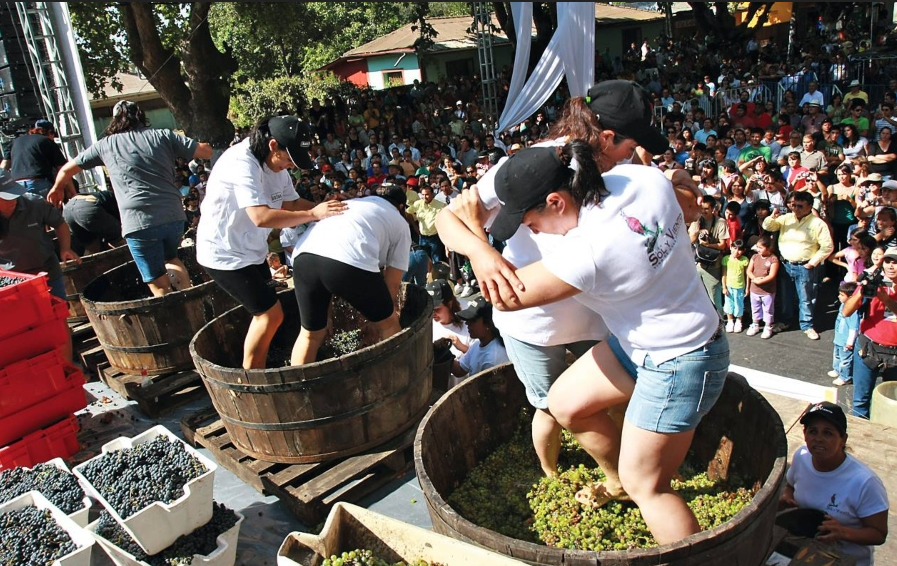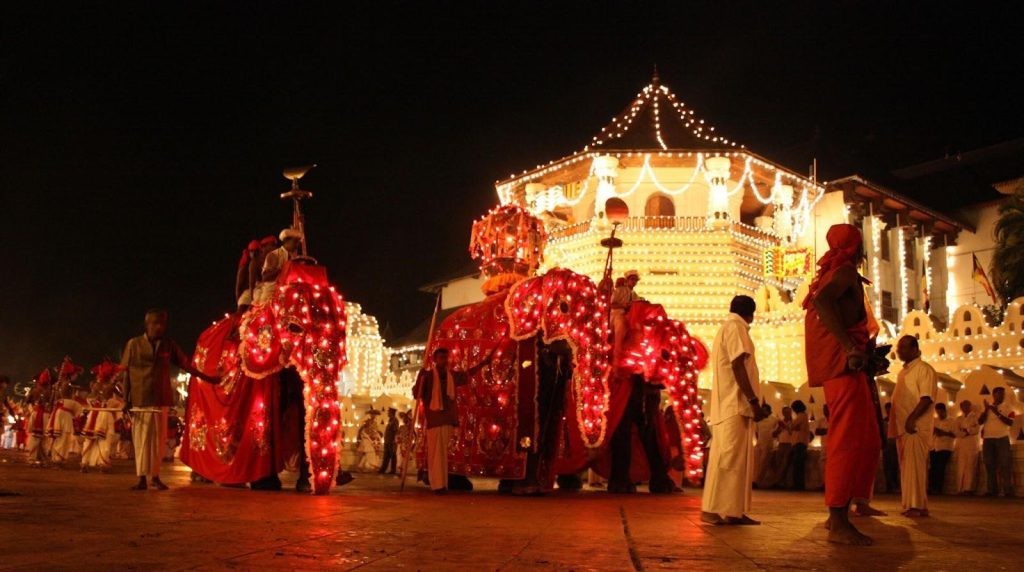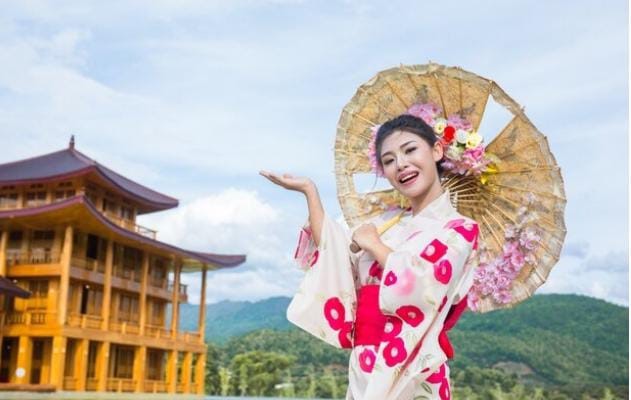What is the Japanese Tea Ceremony?
Just like Italy is known for its pizza and pasta, Mexico for its tacos, and Belgium for its chocolate, Japan is widely known for its tea. The Japanese tea ceremonies organized in Japan are how the people of Japan celebrate their tea-consuming culture. The Japanese tea ceremony is traditionally referred to as chanoyu or sadō. The ceremony is directly translated as ‘the way of tea’. It is a cultural performance that involves the preparation and presentation of green tea (otemae).
Apart from just serving tea, the chanoyu serves as an opportunity for guests to enjoy the hospitality of their hosts. The ceremony is part of the omotenashi, which is the Japanese culture of tending to guests wholeheartedly and it usually takes place in a traditional tea room with a tatami floor. The four principles of the chanoyu include Jaku (tranquility), Wa (harmony), Sei (purity), and Kei (respect). This means that the individuals involved in the ceremony must exhibit these four principles during the process. The chanoyu may take place either formally (chaji) or informally (chakai). In some cases, a slightly different version of the tea ceremony is hosted using tea leaves and is known as senchado.

The Japanese tea ceremony is practiced in many households as a hobby and a celebration of Japanese culture. However, tourists can witness this cultural practice in various organizations across the country. The Chanoyu that are hosted by these organizations vary in terms of authenticity and formality and are hosted in cultural centers, hotels, and Japanese traditional gardens.
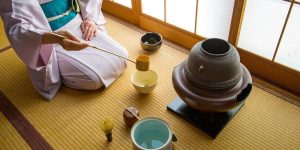
Historic Background of the Japanese Tea Ceremony
Tea was borrowed from the Chinese during the 8th Century when it was first consumed as a medicinal beverage by the higher class and priests in the community. Between 1333 and 1573, tea became popular among people of all social classes. During this time, the Japanese started hosting tea-drinking parties where they had an opportunity to showcase their knowledge about tea and their magnificent tea bowls. Even social houses provided space to accommodate tea drinking among the Japanese.
Over time, more refined Zen-inspired tea parties that dwelled upon simplicity and spirituality were organized in Japan. Such gatherings are credited for the development of the Japanese tea ceremony that exists in the country today. The person who shaped the Japanese way of tea by instilling the culture of rustic simplicity was Sen no Rikyu. He inspired the development of a more sophisticated tea-drinking culture in Japan that is based on spirituality. A majority of the popular schools of tea that exist in Japan today continue to be inspired by his teachings.

Procedures of the Japanese Tea Ceremony
Roji (The Tea House Garden)
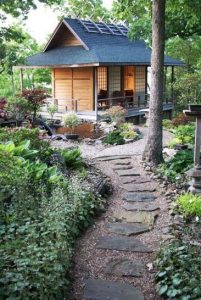
The tea house garden, also known as roji (which means ‘dewy ground’), is a special part of the Japanese tea ceremony. Guests must go through an aesthetic natural garden at the beginning of the process. The design of the garden must be simple and minimalist without any plants with strong smells and bold appearances. The most ideal plants to have in such a garden are evergreen plants with a few seasonal plants to ensure that the garden has a consistent appearance.
For decor, one can include stone sculptures, lanterns, and rocks to achieve a spiritual aesthetic. It is ideal to include a stone path that leads guests to a stone basin where they are required to wash their hands and mouth, an act that symbolizes physical cleansing. Before entering the tea house, guests are also required to remove their shoes. Traditionally, samurai warriors were required to leave their swords at the door with their shoes.
Chashitsu (The Tea House)

Chashitsu is a small tea house, resembling a mountain hut, where the Japanese tea ceremony takes place. Usually, the hut has tatami mats on the floor, a low ceiling, and sliding doors. Before entering, guests showcase their humility by bowing at the tea house’s door. The decor is kept very simple with a simple flower arrangement and windows made of translucent paper (shoji). Every architectural and decor decision made in the creation of a Japanese tea house is based on a set of standards that tea masters perfected for years.
The Tea Ceremony
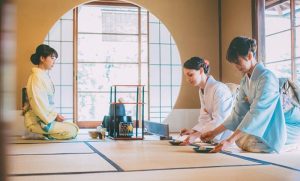
Upon bowing at the Chashitsu’s entrance, the host welcomes the guests inside and they proceed to sit. It is polite to exchange greetings once inside before the tea ceremony kicks off. The tea ceremony begins when the host fills a kettle with water and places it over a charcoal fire. As the water heats, the host readies the utensils that will be used in the tea ceremony, including the tea cloth (fukusa), bamboo tea whisk (chasen), tea scoop (chashaku), and tea bowl (chawan).
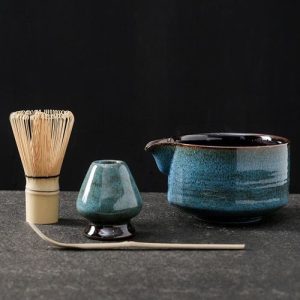
When the water boils, the host pours it into a bowl where they add matcha powder and mix it using the tea whisk until it becomes frothy. Usually, the first batch of tea prepared during the ceremony is referred to as kukicha which means ‘thick tea’. This is usually the highest quality of tea made from matcha that was grown under a shade for three weeks before its harvest. Kukicha usually has a higher caffeine content compared to other teas.
The first bowl of tea is usually shared among all guests. When the host finishes preparing it, they present the bowl of tea to each guest who bows their heads, receives the bowl with both hands, and takes a sip. After kukicha is served and consumed, a thinner tea, known as usucha, is brewed. Unlike kukicha, usucha is made with substantially less matcha tea. The tea ceremony usually goes on for hours and at the end, all the guests usually feel calm and spiritually uplifted.
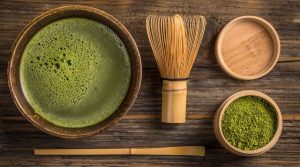
Conclusion
The Japanese have preserved their tea ceremony over several centuries, making it one of the most authentic cultural experiences in the world. The Japanese tea ceremony practices are significantly similar to those established by Sen no Rikyu all these years ago. For this reason, the Japanese tea ceremony is a cultural experience that anyone visiting Japan must undergo.
References
Acar, A. (n.d.). Tea ceremony in Japan. Kimono Tea Ceremony MAIKOYA. https://mai-ko.com/travel/culture-in-japan/tea-ceremony/japanese-tea-ceremony/
Bourne, M. (2022). What is a Japanese tea ceremony and how to attend one. Mizuba Tea Co. https://mizubatea.com/blogs/news-1/what-is-a-tea-ceremony-and-how-to-attend-one?srsltid=AfmBOopMkFuNv6M7NqdsWld6j6hxDUfmCu3cn9XxKVmPLHk_Ypl4Cztb
Japan. Endless. Discovery. (n.d.) Japanese tea ceremony. https://www.japan.travel/en/guide/tea-ceremony/
Japan-guide.com. (2024). Tea ceremony. https://www.japan-guide.com/e/e2096.html
Tea by Birdy. (2024). Japanese tea ceremony. https://teabybirdy.com.au/blogs/news/the-japanese-green-tea-ceremony?srsltid=AfmBOooOea6l_Qoi7HlVfEI0zeOSzRWEDUUwuBtD4oqZepW8QLByi9Pb

